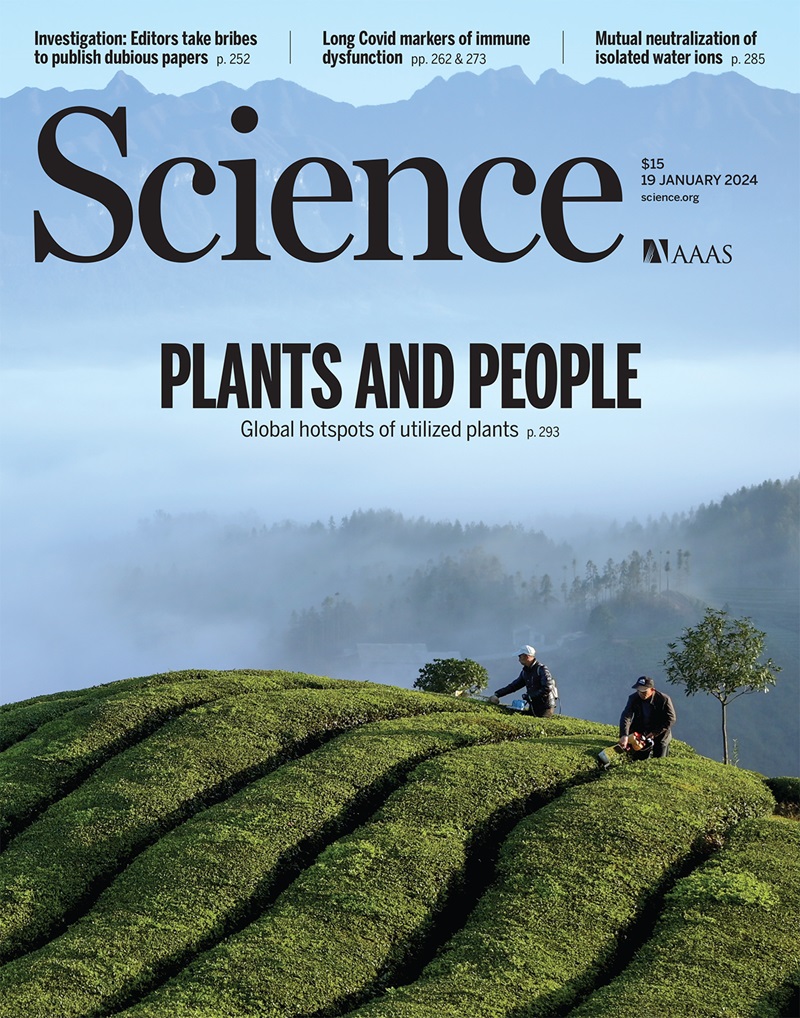Disassembly activates Retron-Septu for antiphage defense
IF 44.7
1区 综合性期刊
Q1 MULTIDISCIPLINARY SCIENCES
引用次数: 0
Abstract
Retrons are antiphage defense systems that produce multicopy single-stranded DNA (msDNA) and hold promises for genome engineering. However, the mechanisms of defense remain unclear. The Retron-Septu system uniquely integrates retron and Septu antiphage defenses. Cryo-electron microscopy structures reveal asymmetric nucleoprotein complexes comprising a reverse transcriptase (RT), msDNA (a hybrid of msdDNA and msrRNA), and two PtuAB copies. msdDNA and msrRNA are essential for assembling this complex, with msrRNA adopting a conserved lariat-like structure that regulates reverse transcription. Notably, the assembled Retron-Septu complex is inactive, with msdDNA occupying the PtuA DNA-binding site. Activation occurs upon disassembly, releasing PtuAB, which degrades single-stranded DNA to restrict phage replication. This “arrest-and-release” mechanism underscores the dynamic regulatory roles of msDNA, advancing our understanding of antiphage defense strategies.拆卸激活逆转录- septu来防御噬菌体
逆转录酶是一种产生多拷贝单链DNA (msDNA)的噬菌体防御系统,有望用于基因组工程。然而,其防御机制尚不清楚。逆转录-Septu系统独特地集成了逆转录和Septu抗噬菌体防御。低温电镜结构显示不对称核蛋白复合物包括逆转录酶(RT)、msDNA (msdDNA和msrRNA的杂交)和两个PtuAB拷贝。msdDNA和msrRNA对于组装该复合体至关重要,其中msrRNA采用保守的lariat样结构来调节逆转录。值得注意的是,组装的Retron-Septu复合体是无活性的,msdDNA占据了PtuA dna结合位点。激活发生在分解时,释放PtuAB,其降解单链DNA以限制噬菌体复制。这种“捕获-释放”机制强调了msDNA的动态调控作用,促进了我们对抗噬菌体防御策略的理解。
本文章由计算机程序翻译,如有差异,请以英文原文为准。
求助全文
约1分钟内获得全文
求助全文
来源期刊

Science
综合性期刊-综合性期刊
CiteScore
61.10
自引率
0.90%
发文量
0
审稿时长
2.1 months
期刊介绍:
Science is a leading outlet for scientific news, commentary, and cutting-edge research. Through its print and online incarnations, Science reaches an estimated worldwide readership of more than one million. Science’s authorship is global too, and its articles consistently rank among the world's most cited research.
Science serves as a forum for discussion of important issues related to the advancement of science by publishing material on which a consensus has been reached as well as including the presentation of minority or conflicting points of view. Accordingly, all articles published in Science—including editorials, news and comment, and book reviews—are signed and reflect the individual views of the authors and not official points of view adopted by AAAS or the institutions with which the authors are affiliated.
Science seeks to publish those papers that are most influential in their fields or across fields and that will significantly advance scientific understanding. Selected papers should present novel and broadly important data, syntheses, or concepts. They should merit recognition by the wider scientific community and general public provided by publication in Science, beyond that provided by specialty journals. Science welcomes submissions from all fields of science and from any source. The editors are committed to the prompt evaluation and publication of submitted papers while upholding high standards that support reproducibility of published research. Science is published weekly; selected papers are published online ahead of print.
 求助内容:
求助内容: 应助结果提醒方式:
应助结果提醒方式:


